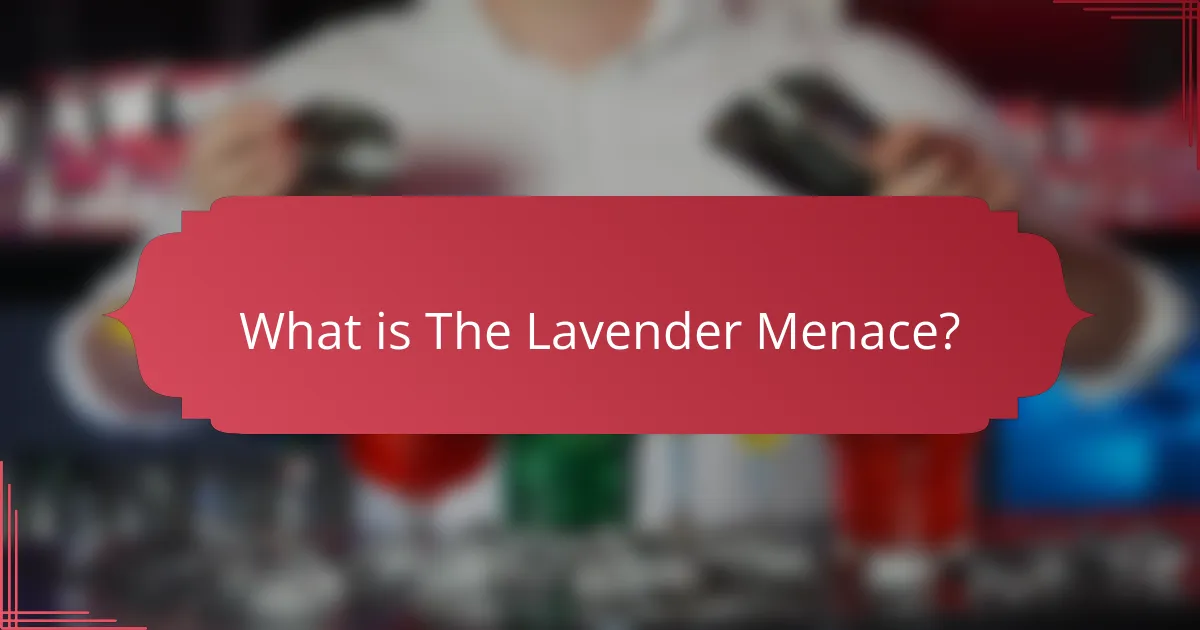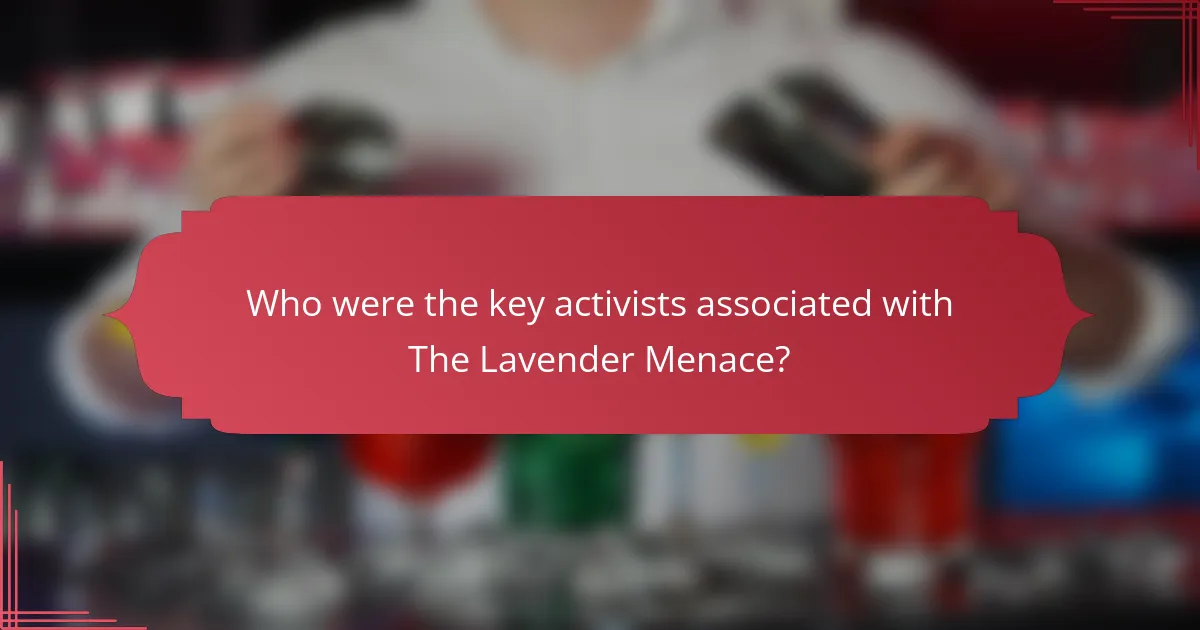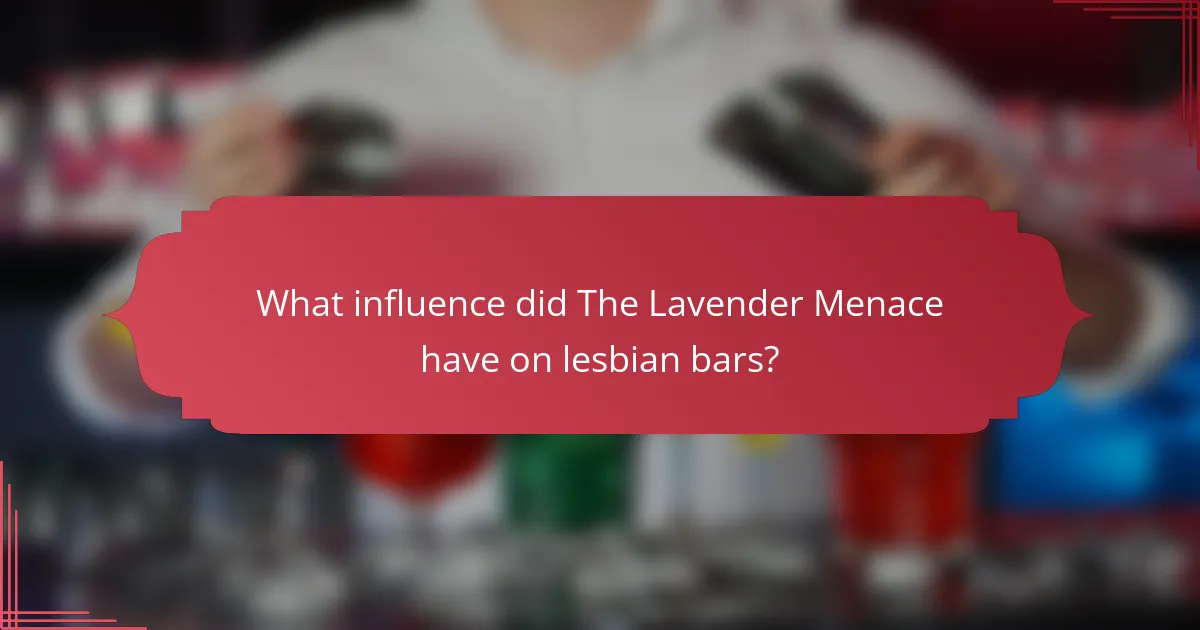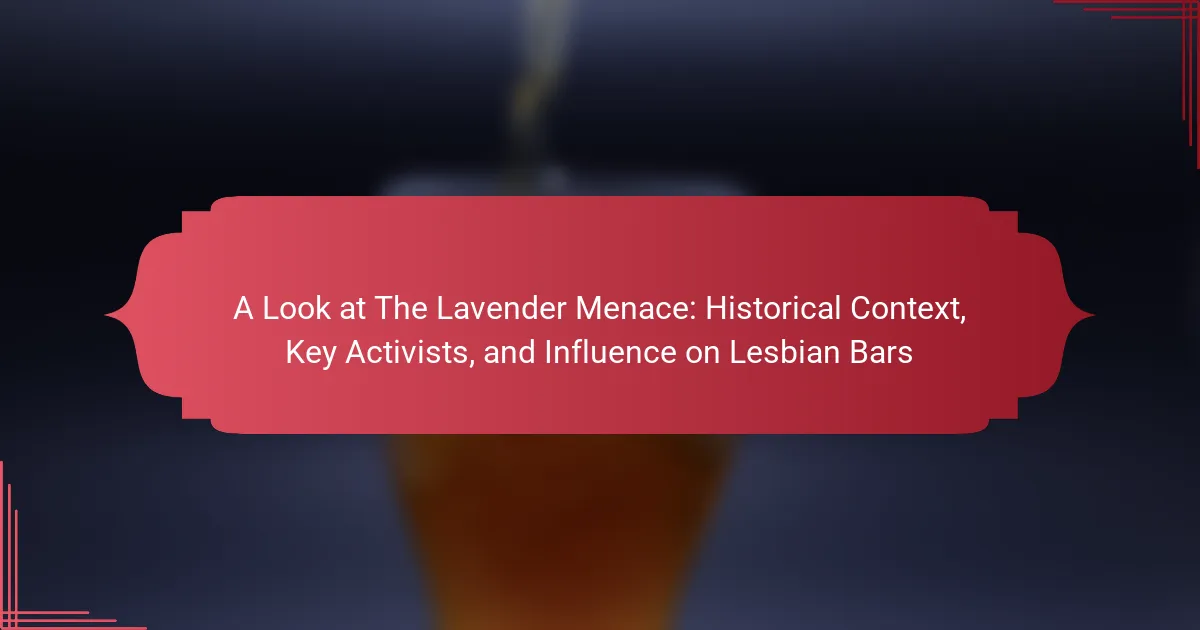
What is The Lavender Menace?
The Lavender Menace refers to a feminist lesbian group active in the 1970s. This group emerged in response to the perceived marginalization of lesbians within the feminist movement. The Lavender Menace sought to challenge societal norms and advocate for lesbian visibility. They organized protests and events to raise awareness of lesbian issues. The name symbolizes the intersection of feminism and lesbian identity. Their activism influenced the broader [censured] rights movement. The Lavender Menace played a crucial role in promoting lesbian culture and community. They contributed to the establishment of lesbian bars as safe spaces for women.
How did The Lavender Menace emerge in the historical context?
The Lavender Menace emerged in the historical context of the 1970s as a response to the marginalization of lesbian voices in the feminist movement. This group sought to challenge the prevailing norms that excluded lesbian identities from mainstream feminism. The Lavender Menace was founded by activists like Rita Mae Brown and others who believed that lesbian issues were vital to the feminist agenda. Their emergence coincided with the broader [censured] liberation movement, which sought to address issues of sexuality and gender equality. The Lavender Menace organized protests and events to raise awareness of lesbian rights. They aimed to redefine feminism to be more inclusive of diverse [censured] orientations. This activism was pivotal in bringing lesbian visibility to the forefront of feminist discourse. Their efforts contributed to a shift in how lesbian identities were perceived within both feminist and [censured] communities.
What events led to the formation of The Lavender Menace?
The Lavender Menace formed in response to the exclusion of lesbian voices from the feminist movement. In the early 1970s, many feminists marginalized lesbian issues. This led to frustration among lesbians who felt their experiences were overlooked. The term “Lavender Menace” was coined by Betty Friedan in 1969. Friedan referred to the presence of lesbians as a threat to the feminist movement. In 1970, a group of lesbians organized a protest at the Second Congress to Unite Women. They aimed to demand recognition and inclusion. This protest marked a significant moment in lesbian activism. The Lavender Menace ultimately became a symbol of lesbian empowerment within feminism.
Who were the key figures involved in the early days of The Lavender Menace?
The key figures involved in the early days of The Lavender Menace included activists such as Barbara Smith, Audre Lorde, and Rita Mae Brown. Barbara Smith was a co-founder of the Combahee River Collective and a prominent voice in the feminist and lesbian movements. Audre Lorde was a renowned poet and activist who advocated for intersectionality in feminism. Rita Mae Brown was an influential writer and activist, known for her novel “Rubyfruit Jungle,” which highlighted lesbian experiences. These figures played crucial roles in shaping the movement and advocating for lesbian visibility and rights during the 1970s. Their contributions helped to challenge societal norms and promote a sense of community among lesbians.
What role did The Lavender Menace play in the [censured] rights movement?
The Lavender Menace played a crucial role in the [censured] rights movement by advocating for lesbian visibility and inclusion. Founded in the early 1970s, it emerged as a response to the male-dominated [censured] rights organizations. The group sought to challenge the marginalization of lesbians within the broader [censured] community.
They organized protests and events to raise awareness about lesbian issues. The Lavender Menace also contributed to the formation of feminist and [censured] coalitions. Their activism highlighted the need for intersectionality in the fight for rights. This focus on lesbian identity helped shape future advocacy efforts.
Their influence is evident in the increased representation of lesbians in [censured] spaces. The Lavender Menace remains a symbol of the fight for equality and recognition within the movement.
How did The Lavender Menace influence public perception of lesbian identities?
The Lavender Menace significantly influenced public perception of lesbian identities by challenging stereotypes and advocating visibility. This group emerged in the 1970s as a response to the mainstream feminist movement’s neglect of lesbian issues. They organized protests and events that highlighted the experiences of lesbians. Their activism brought attention to the unique struggles faced by lesbian women. Public demonstrations, such as the “Lavender Menace” protest at the 1970 Second Congress to Unite Women, showcased their demands. This visibility helped reshape societal views on lesbian identities. The Lavender Menace’s efforts contributed to greater acceptance and understanding of diverse [censured] orientations. Their legacy continues to influence contemporary [censured] activism.
What were the major accomplishments attributed to The Lavender Menace?
The Lavender Menace accomplished significant advocacy for lesbian visibility and rights. They organized protests that highlighted the exclusion of lesbians from the feminist movement. Their activism contributed to the broader [censured] rights movement in the 1970s. The Lavender Menace also fostered community among lesbians, creating safe spaces for discussion and support. They challenged societal norms and stereotypes about lesbian identity. Their efforts led to increased representation of lesbians in feminist literature and activism. The Lavender Menace helped to shift perceptions within the feminist movement, emphasizing the importance of intersectionality. Their legacy continues to influence [censured] activism today.

Who were the key activists associated with The Lavender Menace?
Key activists associated with The Lavender Menace include Barbara Smith, Audre Lorde, and Rita Mae Brown. These individuals played significant roles in advocating for lesbian visibility and rights during the feminist movement of the 1970s. Barbara Smith co-founded the Combahee River Collective, emphasizing the intersectionality of race and gender. Audre Lorde was a prominent poet and activist who highlighted the experiences of black lesbians. Rita Mae Brown authored the influential book “Rubyfruit Jungle,” which addressed lesbian identity. Their contributions helped shape the discourse around lesbian feminism and visibility.
What contributions did prominent activists make to The Lavender Menace?
Prominent activists contributed significantly to The Lavender Menace by advocating for [censured] rights and visibility. Key figures like Barbara Gittings and Kay Lahusen organized protests and awareness campaigns. They challenged the exclusion of lesbian voices in the feminist movement. Their activism highlighted the intersection of gender and [censured] identity. They also worked to create safe spaces for lesbians within the broader [censured] community. Their efforts helped to shape public perception and acceptance of lesbian identities. The Lavender Menace became a symbol of resistance against oppression. Their contributions laid the groundwork for future [censured] activism and rights movements.
How did these activists shape the direction of [censured] advocacy?
Activists shaped the direction of [censured] advocacy by challenging societal norms and advocating for rights. They brought visibility to lesbian issues within the broader [censured] movement. Key figures, such as those involved in the Lavender Menace, highlighted intersectionality in advocacy. Their efforts led to increased representation in media and politics. Activists organized protests and events that raised public awareness. The Stonewall riots in 1969 marked a pivotal moment for [censured] rights. This activism inspired future generations to continue the fight for equality. Their legacy is evident in ongoing advocacy for diverse [censured] orientations and gender identities.
What unique perspectives did these activists bring to the movement?
These activists brought intersectional perspectives to the movement. They highlighted the unique challenges faced by lesbians within the broader feminist and [censured] movements. Their focus included issues of race, class, and sexuality. This broadened the scope of advocacy beyond mainstream narratives. They emphasized the importance of visibility for marginalized groups. Their activism fostered a sense of community and solidarity among diverse identities. This approach led to more inclusive policies and representation. Historical events, like the 1970s lesbian bar scene, were shaped by their contributions.
How did the activism of The Lavender Menace intersect with other social movements?
The activism of The Lavender Menace intersected with feminist movements and civil rights efforts. The Lavender Menace emerged in the 1970s, advocating for lesbian visibility within the broader feminist movement. They challenged the exclusion of lesbians from feminist discourse, which was often dominated by heterosexual perspectives.
Their protests and actions, such as the 1970 Lavender Menace demonstration at the Second Congress to Unite Women, highlighted the need for inclusivity. This event garnered attention and sparked discussions on the intersectionality of gender and [censured] orientation.
Additionally, The Lavender Menace aligned with civil rights movements by advocating for [censured] rights alongside racial and gender equality. Their activism contributed to the broader push for social justice, emphasizing that all marginalized groups deserved representation and rights.
This intersection of activism helped shape future movements, laying groundwork for the modern [censured] rights movement. Their efforts were crucial in creating a more inclusive feminist agenda, influencing subsequent generations of activists.
What alliances were formed between The Lavender Menace and other activist groups?
The Lavender Menace formed alliances with various activist groups, including feminist organizations and [censured] rights groups. These alliances aimed to amplify the voices of marginalized communities. The Lavender Menace collaborated with groups like the Women’s Liberation Movement. They also engaged with [censured] organizations to address issues affecting lesbian visibility. This collaboration helped in organizing protests and events. The alliances strengthened the fight against discrimination and violence. They contributed to a broader movement for equality. These partnerships were crucial in shaping the discourse around lesbian rights in the 1970s.
How did these intersections strengthen the overall movement for equality?
Intersections strengthened the overall movement for equality by uniting diverse groups. These groups included women, [censured] individuals, and racial minorities. Their collaboration amplified voices that were often marginalized. Shared experiences fostered solidarity and mutual support. This unity led to broader coalitions advocating for rights. For instance, the Stonewall riots in 1969 included various identities fighting against oppression. The visibility of these intersections highlighted systemic inequalities. This awareness pushed for inclusive policies and representation. Ultimately, the intersections created a more powerful and unified front for equality.

What influence did The Lavender Menace have on lesbian bars?
The Lavender Menace significantly influenced lesbian bars by advocating for visibility and acceptance. This group emerged in the 1970s, challenging the mainstream feminist movement’s exclusion of lesbian identities. Their activism encouraged the creation of safe spaces for lesbians. As a result, lesbian bars began to flourish as community hubs. These venues became places for socializing and activism. They also provided a platform for political discussions and cultural expression. The Lavender Menace’s influence helped shift societal perceptions of lesbianism. This shift contributed to the normalization of lesbian spaces within the broader [censured] community.
How did The Lavender Menace contribute to the culture of lesbian bars?
The Lavender Menace significantly contributed to the culture of lesbian bars by fostering a sense of community and visibility. This group emerged in the 1970s as a response to the marginalization of lesbians within the feminist movement. They organized events and protests, which drew attention to lesbian issues and rights. Their activism helped to create safe spaces for lesbians, particularly in bars where they could express their identities freely. The Lavender Menace also influenced the decor and themes of lesbian bars, making them more inclusive and welcoming. Their efforts led to increased patronage and support for these establishments. This cultural shift reinforced the importance of lesbian bars as social hubs for the community.
What specific changes occurred in lesbian bars due to The Lavender Menace’s influence?
The Lavender Menace influenced lesbian bars by promoting inclusivity and visibility. This movement encouraged bars to become safe spaces for all women, regardless of [censured] orientation. Many establishments began hosting events that celebrated lesbian culture. Increased representation of lesbian identity in bar promotions became common. The Lavender Menace also inspired the formation of lesbian-centric organizations within these spaces. These changes fostered a sense of community and belonging among patrons. As a result, lesbian bars evolved into hubs for activism and social change. The impact of The Lavender Menace can be seen in the lasting legacy of these establishments today.
How did these bars serve as safe spaces for the community?
These bars served as safe spaces for the community by providing a refuge for individuals to express their identities freely. They offered a welcoming environment where patrons could socialize without fear of discrimination. Many lesbian bars became central hubs for activism and community organizing. Events held in these spaces fostered solidarity and support among marginalized individuals. Historical accounts show that during times of oppression, these bars were among the few places where [censured] individuals felt secure. They also provided resources and information about rights and advocacy. The presence of these venues contributed to a sense of belonging and community cohesion.
What role do lesbian bars play in preserving the legacy of The Lavender Menace?
Lesbian bars serve as vital spaces for preserving the legacy of The Lavender Menace. These establishments provide a sense of community and belonging for lesbian individuals. They host events that celebrate lesbian history and activism, directly linking to The Lavender Menace’s mission. Many lesbian bars display memorabilia and host discussions about historical events related to [censured] rights. This fosters awareness and education among patrons about the struggles and achievements of past activists. Furthermore, lesbian bars often support local [censured] organizations, continuing the advocacy work initiated by The Lavender Menace. By offering a safe space, they uphold the values of empowerment and visibility that The Lavender Menace championed. Thus, lesbian bars play a crucial role in maintaining the cultural and historical significance of this movement.
How do contemporary lesbian bars honor the history of The Lavender Menace?
Contemporary lesbian bars honor the history of The Lavender Menace by celebrating their activism and cultural significance. These bars often feature events that highlight [censured] history and the contributions of key activists. They may display memorabilia or art that reflects the era of The Lavender Menace. Many bars create safe spaces that echo the original intent of The Lavender Menace to promote visibility and acceptance. The bars often host discussions or performances that educate patrons about the struggles faced by the community. Additionally, some bars partner with [censured] organizations to support ongoing advocacy efforts. This commitment to honoring the past fosters a sense of community and continuity.
What events or initiatives are inspired by The Lavender Menace in today’s lesbian bars?
Today’s lesbian bars host events and initiatives inspired by The Lavender Menace, focusing on [censured] visibility and empowerment. Many bars organize themed nights that celebrate lesbian culture and history. Events often include drag shows, spoken word performances, and art exhibits. These initiatives aim to create safe spaces for community engagement. Additionally, some bars collaborate with local activists to support [censured] rights. Fundraising events for [censured] organizations are also common. Many bars feature educational programs that highlight the history of lesbian activism. These activities reflect the ongoing influence of The Lavender Menace in promoting inclusivity and visibility.
What lessons can be learned from The Lavender Menace’s impact on activism and culture?
The Lavender Menace taught important lessons about the power of visibility in activism. Their actions emphasized the need for representation of marginalized groups within broader movements. They challenged the mainstream feminist narrative that often excluded lesbian voices. This highlighted the importance of intersectionality in activism. The Lavender Menace also demonstrated the effectiveness of grassroots organizing. Their efforts mobilized community support and raised awareness on [censured] issues. Historical events, such as the 1970 Lavender Menace demonstration at the Second Congress to Unite Women, showcased their impact. This event forced the feminist movement to confront its shortcomings regarding inclusivity. Overall, their legacy underscores the necessity of diverse voices in social movements for meaningful change.
How can current activists apply the strategies of The Lavender Menace today?
Current activists can apply the strategies of The Lavender Menace today by focusing on visibility and direct action. The Lavender Menace emphasized the importance of lesbian visibility within the broader feminist movement. Activists can organize events that highlight [censured] issues and experiences. They can also create coalitions that unite diverse groups for collective advocacy. Engaging in public demonstrations can raise awareness and challenge societal norms. Additionally, using social media platforms to amplify marginalized voices can replicate their strategy of visibility. Historical context shows that The Lavender Menace successfully disrupted mainstream narratives. Their approach fostered solidarity among activists, which remains crucial today.
What are the best practices for fostering inclusive spaces in the [censured] community?
Fostering inclusive spaces in the [censured] community involves several best practices. First, ensure representation by including diverse voices in decision-making. This can be achieved by inviting community members to participate in planning and events. Second, create safe environments by implementing clear anti-discrimination policies. These policies should be communicated effectively to all participants. Third, provide training on [censured] issues for staff and volunteers. This training should cover topics like cultural competency and sensitivity. Fourth, actively seek feedback from community members. This helps identify areas for improvement and ensures ongoing engagement. Lastly, celebrate diversity through events that highlight various identities within the community. These practices contribute to a more inclusive and welcoming atmosphere.
The Lavender Menace is a feminist lesbian group that emerged in the 1970s to address the marginalization of lesbians within the feminist movement. This article explores the historical context of their formation, key activists involved, and their significant influence on the [censured] rights movement and lesbian bars. It highlights the group’s efforts to advocate for lesbian visibility, challenge societal norms, and create safe spaces for women. Additionally, the article examines how the legacy of The Lavender Menace continues to shape contemporary activism and culture within the [censured] community.
